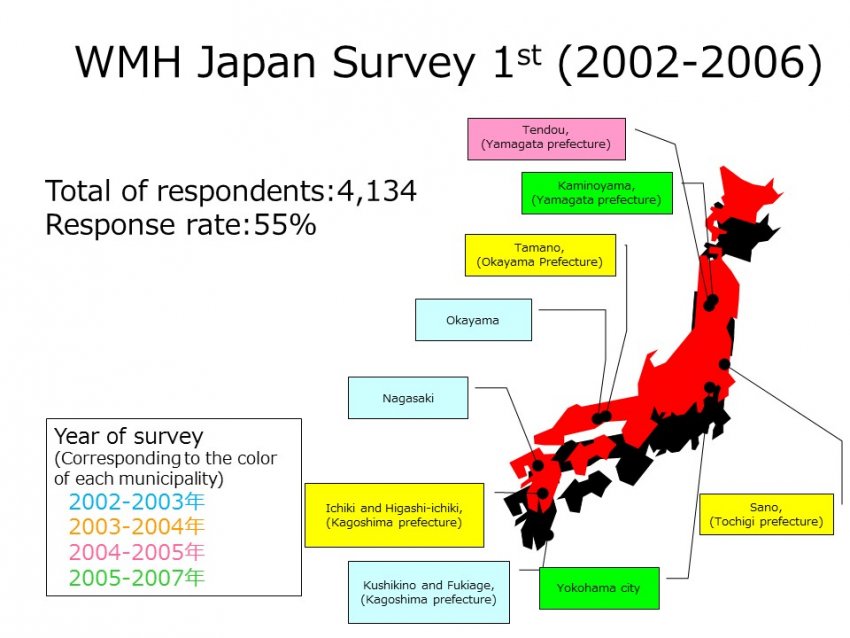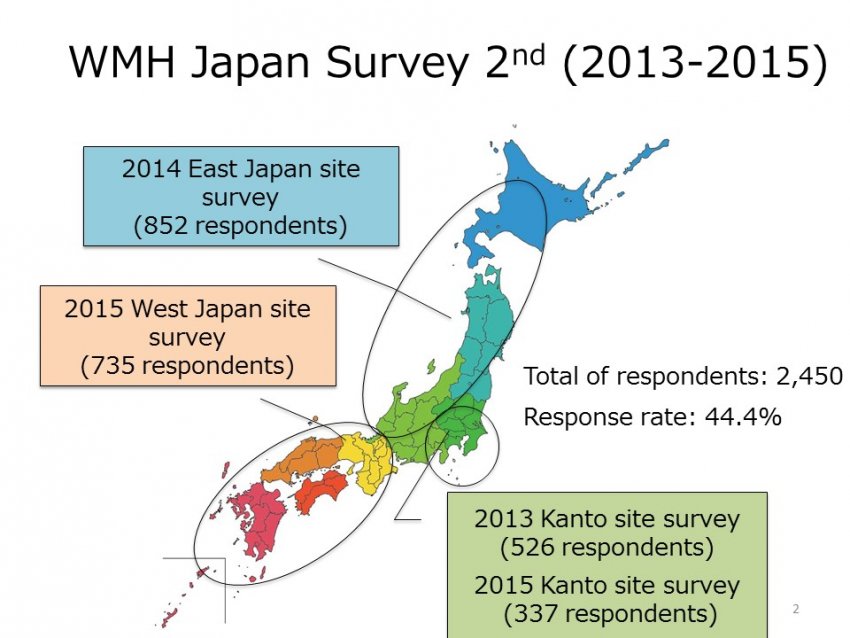Investigating the Mental Health of Japanese Population


Norito Kawakami
Graduate School of Medicine
Department of Mental Health, School of Public Health Professor
We are conducting the World Mental Health (WMH) Japan Survey for comprehensive understanding of mental health among Japanese general population, as part of a coordinated series of WMH surveys, through collaboration with Harvard Medical School. The WMH Surveys aim to obtain accurate cross-national information about the prevalence and correlates of mental, substance, and behavioral disorders. Coordinated WMH surveys have been conducted in more than 30 countries (as of March, 2018).
In the WMH Japan Survey, we aim to:
1. Identify related factors for promoting mental health and treatment behaviors
2. Measure the influences of changes in the Japanese social environment on mental health among Japanese general population
3. Trace the changes in the mental health conditions of individuals every 10 years
4. Observe the mental health of survivors in temporary housing and residents of Fukushima prefecture after the Great East Japan Earthquake
5. Discover new findings and differences among WMH countries in an international comparison study.
Main findings of the WMH Japan Survey study include;
First, we obtained the prevalence of common mental disorders, suicidal behaviors, substance abuse, and behavioral disorders such as Hikikomori in Japan.
Second, we reported the treatment gap and patterns of psychological barriers to the use of mental health service among those with common mental disorders in Japan.
Third, we found that the prevalence and treatment rates of mental disorders were lower in Japan than in most other WMH participant countries.
Forth, in the WMH Japan Survey conducted between 2002 and 2015, we found a significant increase in treatment rates for common mental disorders, although we found no significant change in the prevalence of common mental disorders.
Finally, we also found that the incidence rate of common mental disorders among residents in disaster-hit areas of the Great East Japan Earthquake increased twice as much as that of Japanese general population in the immediate wake of the disaster
The WMH Japan Survey primarily aims to achieve the United Nations’ Sustainable Development Goals (SDGs) No.3 "Ensure healthy lives and promote well-being for all at all ages."
Focusing on two subordinate targets of SDGs Goal 3: the treatment and the promoting mental health and well-being (Target 3.4) and the prevention and treatment of substance abuse and harmful use of alcohol (Target 3.5), we also contribute to other SDGs (ensuring the equitable opportunities for employment and education, realizing an inclusive society, reducing inequality inter-nations and among nations, enhancing secure environments, promoting mental health, and improve productivity).
In the WMH Japan Survey, we aim to:
1. Identify related factors for promoting mental health and treatment behaviors
2. Measure the influences of changes in the Japanese social environment on mental health among Japanese general population
3. Trace the changes in the mental health conditions of individuals every 10 years
4. Observe the mental health of survivors in temporary housing and residents of Fukushima prefecture after the Great East Japan Earthquake
5. Discover new findings and differences among WMH countries in an international comparison study.
Main findings of the WMH Japan Survey study include;
First, we obtained the prevalence of common mental disorders, suicidal behaviors, substance abuse, and behavioral disorders such as Hikikomori in Japan.
Second, we reported the treatment gap and patterns of psychological barriers to the use of mental health service among those with common mental disorders in Japan.
Third, we found that the prevalence and treatment rates of mental disorders were lower in Japan than in most other WMH participant countries.
Forth, in the WMH Japan Survey conducted between 2002 and 2015, we found a significant increase in treatment rates for common mental disorders, although we found no significant change in the prevalence of common mental disorders.
Finally, we also found that the incidence rate of common mental disorders among residents in disaster-hit areas of the Great East Japan Earthquake increased twice as much as that of Japanese general population in the immediate wake of the disaster
The WMH Japan Survey primarily aims to achieve the United Nations’ Sustainable Development Goals (SDGs) No.3 "Ensure healthy lives and promote well-being for all at all ages."
Focusing on two subordinate targets of SDGs Goal 3: the treatment and the promoting mental health and well-being (Target 3.4) and the prevention and treatment of substance abuse and harmful use of alcohol (Target 3.5), we also contribute to other SDGs (ensuring the equitable opportunities for employment and education, realizing an inclusive society, reducing inequality inter-nations and among nations, enhancing secure environments, promoting mental health, and improve productivity).
Related links
Research collaborators
- Ronald C. Kessler, PhD, Harvard Medical School.
- Other Co-workers from 30 countries worldwide.
- Other Co-workers from 30 countries worldwide.
Related publications
- Ishikawa, H., et al., Lifetime and 12-month prevalence, severity and unmet need for treatment of common mental disorders in Japan: results from the final dataset of World Mental Health Japan Survey. Epidemiol Psychiatr Sci, 2016. 25(3): p. 217-29.
- Kido, Y., N. Kawakami, and W.H.O.W.M.H.J.S. Group, Sociodemographic determinants of attitudinal barriers in the use of mental health services in Japan: findings from the World Mental Health Japan Survey 2002-2006. Psychiatry Clin Neurosci, 2013. 67(2): p. 101-9.
- Umeda, M., N. Kawakami, and G. World Mental Health Japan Survey, Association of childhood family environments with the risk of social withdrawal ('hikikomori') in the community population in Japan. Psychiatry Clin Neurosci, 2012. 66(2): p. 121-9.
- Kawakami, N., et al., Early-life mental disorders and adult household income in the World Mental Health Surveys. Biol Psychiatry, 2012. 72(3): p. 228-37.
- Sado, M., et al., Cost of depression among adults in Japan in 2005. Psychiatry Clin Neurosci, 2011. 65(5): p. 442-50.
- Koyama, A., et al., Lifetime prevalence, psychiatric comorbidity and demographic correlates of "hikikomori" in a community population in Japan. Psychiatry Res, 2010. 176(1): p. 69-74.
- Ono, Y., et al., Prevalence of and risk factors for suicide-related outcomes in the World Health Organization World Mental Health Surveys Japan. Psychiatry Clin Neurosci, 2008. 62(4): p. 442-9.
- Kido, Y., N. Kawakami, and W.H.O.W.M.H.J.S. Group, Sociodemographic determinants of attitudinal barriers in the use of mental health services in Japan: findings from the World Mental Health Japan Survey 2002-2006. Psychiatry Clin Neurosci, 2013. 67(2): p. 101-9.
- Umeda, M., N. Kawakami, and G. World Mental Health Japan Survey, Association of childhood family environments with the risk of social withdrawal ('hikikomori') in the community population in Japan. Psychiatry Clin Neurosci, 2012. 66(2): p. 121-9.
- Kawakami, N., et al., Early-life mental disorders and adult household income in the World Mental Health Surveys. Biol Psychiatry, 2012. 72(3): p. 228-37.
- Sado, M., et al., Cost of depression among adults in Japan in 2005. Psychiatry Clin Neurosci, 2011. 65(5): p. 442-50.
- Koyama, A., et al., Lifetime prevalence, psychiatric comorbidity and demographic correlates of "hikikomori" in a community population in Japan. Psychiatry Res, 2010. 176(1): p. 69-74.
- Ono, Y., et al., Prevalence of and risk factors for suicide-related outcomes in the World Health Organization World Mental Health Surveys Japan. Psychiatry Clin Neurosci, 2008. 62(4): p. 442-9.
Contact
- Norito Kawakami
- Email: kawakami[at]m.u-tokyo.ac.jp
※[at]=@













